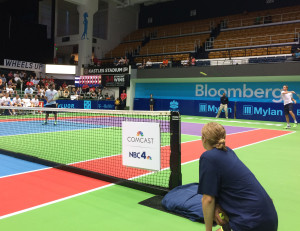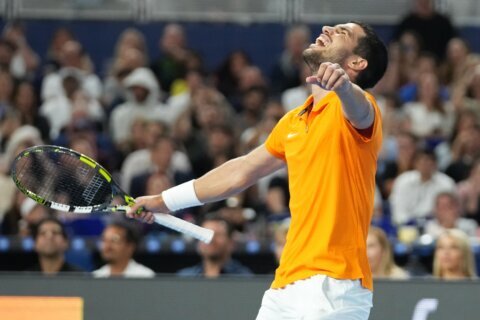WASHINGTON — Meet Sam Querrey.
The second highest-ranked American man, he’s a top-30 player in the world, a 6-foot-6, thunderous serving, 27-year-old Californian in the prime of his career. He’s well-known on the circuit and among the young tennis fans at Kastles Stadium as he warms up before a match, shrieking his name, asking for a ball, an autograph, or even just a high-five. But without a quarterfinal appearance in a major, he flies under the radar on a national scale.
Hence the word “meet.” The current generation of top American men’s tennis stars live in a terrifically long and far-cast shadow. After all, their predecessors, from Courier to Chang, from Sampras to Agassi to even Andy Roddick, each achieved the top ranking in the world in their prime.
“Those freaking guys back in the day set the bar so high, with every guy reaching number one in the world,” he says, speaking before the annual Kastles Charity Classic last week. “So anything less than that, it’s like, ‘why aren’t you as good as those guys?’”
For the top American men in today’s game, the difference between outside expectation and personal expectation may be drastic. And as the excitement builds for the up-and-comers — there are four American juniors in the top 10 — the current crop of stars find themselves clouded in a haze coming at them from both directions.
While some casual fans might remember John Isner (19th in the world and the top American) from his epic, three-day match at Wimbledon five years ago, they would be hard-pressed to pick Jack Sock (35), Steve Johnson (48) or Donald Young (54) out of a crowd. Although you might not think it, with only one American man lasting as long as four rounds at Wimbledon, but Querrey feels they are poised for a good showing at the Citi Open, where qualifying begins this Saturday at Rock Creek Park Tennis Center.
Before his own stint at the All England Club — where he ran into Roger Federer in the second round — Querrey had made the final of the previous week’s tournament, beating a pair of top-25 players along the way. In the two tournaments he’s played stateside this year, he’s made one final and one semifinal, in Houston and Memphis, respectively.

So while it may not exactly be a home court, is there a home country advantage for Americans?
“Absolutely,” he says. “We have most of our success in the U.S.”
Six of Querrey’s seven ATP titles have come in the states. Similarly, eight of Isner’s nine wins have been in his home country.
“We joke around about it when we’re outside of America, but we like being with our friends and family,” says Querrey. “We like having SportsCenter to watch at night. We like what we grew up with. Everyone’s more comfortable under those circumstances.”
The comfort of home, and particularly of D.C., may work in Querrey’s favor even more so in 2015. He has never played a full season of World Team Tennis until this year, coming in as a hired gun for a couple of matches the last handful of years. This is also the first year he has competed for the Kastles, allowing him a few weeks to get acclimated to the area leading into the Citi Open. With the Kastles hosting the WTT Eastern Conference Championships Thursday (and, if they win, the Finals Sunday), Querrey can have his coach join him this week in preparation for the challenge ahead.
But right now, he’s focused on winning a title. And he actually feels more of a burden to perform in this setting than when on his own on the ATP Tour or even the Davis Cup.
“When I’m out there, I feel way more pressure here than any of that,” he says. “You get that real life pressure that you can’t replicate in practice.”
That pressure will be at its peak as the Kastles look to lock up an unprecedented fifth consecutive WTT title this weekend.







